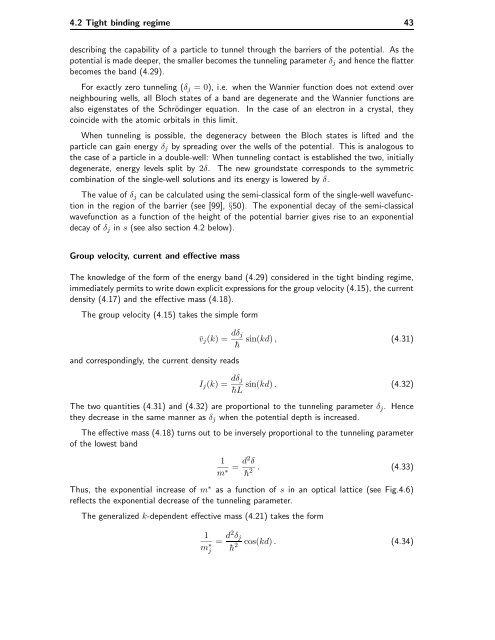Bose-Einstein Condensates in Rotating Traps and Optical ... - BEC
Bose-Einstein Condensates in Rotating Traps and Optical ... - BEC
Bose-Einstein Condensates in Rotating Traps and Optical ... - BEC
Create successful ePaper yourself
Turn your PDF publications into a flip-book with our unique Google optimized e-Paper software.
4.2 Tight b<strong>in</strong>d<strong>in</strong>g regime 43<br />
describ<strong>in</strong>g the capability of a particle to tunnel through the barriers of the potential. As the<br />
potential is made deeper, the smaller becomes the tunnel<strong>in</strong>g parameter δj <strong>and</strong> hence the flatter<br />
becomes the b<strong>and</strong> (4.29).<br />
For exactly zero tunnel<strong>in</strong>g (δj =0), i.e. when the Wannier function does not extend over<br />
neighbour<strong>in</strong>g wells, all Bloch states of a b<strong>and</strong> are degenerate <strong>and</strong> the Wannier functions are<br />
also eigenstates of the Schröd<strong>in</strong>ger equation. In the case of an electron <strong>in</strong> a crystal, they<br />
co<strong>in</strong>cide with the atomic orbitals <strong>in</strong> this limit.<br />
When tunnel<strong>in</strong>g is possible, the degeneracy between the Bloch states is lifted <strong>and</strong> the<br />
particle can ga<strong>in</strong> energy δj by spread<strong>in</strong>g over the wells of the potential. This is analogous to<br />
the case of a particle <strong>in</strong> a double-well: When tunnel<strong>in</strong>g contact is established the two, <strong>in</strong>itially<br />
degenerate, energy levels split by 2δ. The new groundstate corresponds to the symmetric<br />
comb<strong>in</strong>ation of the s<strong>in</strong>gle-well solutions <strong>and</strong> its energy is lowered by δ.<br />
The value of δj can be calculated us<strong>in</strong>g the semi-classical form of the s<strong>in</strong>gle-well wavefunction<br />
<strong>in</strong> the region of the barrier (see [99], §50). The exponential decay of the semi-classical<br />
wavefunction as a function of the height of the potential barrier gives rise to an exponential<br />
decay of δj <strong>in</strong> s (see also section 4.2 below).<br />
Group velocity, current <strong>and</strong> effective mass<br />
The knowledge of the form of the energy b<strong>and</strong> (4.29) considered <strong>in</strong> the tight b<strong>in</strong>d<strong>in</strong>g regime,<br />
immediately permits to write down explicit expressions for the group velocity (4.15), the current<br />
density (4.17) <strong>and</strong> the effective mass (4.18).<br />
The group velocity (4.15) takes the simple form<br />
¯vj(k) = dδj<br />
¯h<br />
<strong>and</strong> correspond<strong>in</strong>gly, the current density reads<br />
s<strong>in</strong>(kd) , (4.31)<br />
Ij(k) = dδj<br />
s<strong>in</strong>(kd) . (4.32)<br />
¯hL<br />
The two quantities (4.31) <strong>and</strong> (4.32) are proportional to the tunnel<strong>in</strong>g parameter δj. Hence<br />
they decrease <strong>in</strong> the same manner as δj when the potential depth is <strong>in</strong>creased.<br />
The effective mass (4.18) turns out to be <strong>in</strong>versely proportional to the tunnel<strong>in</strong>g parameter<br />
of the lowest b<strong>and</strong><br />
1<br />
m∗ = d2δ 2 . (4.33)<br />
¯h<br />
Thus, the exponential <strong>in</strong>crease of m∗ as a function of s <strong>in</strong> an optical lattice (see Fig.4.6)<br />
reflects the exponential decrease of the tunnel<strong>in</strong>g parameter.<br />
The generalized k-dependent effective mass (4.21) takes the form<br />
1<br />
m ∗ j<br />
= d2δj 2 cos(kd) . (4.34)<br />
¯h




